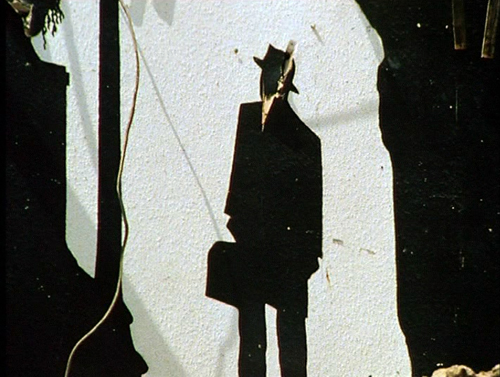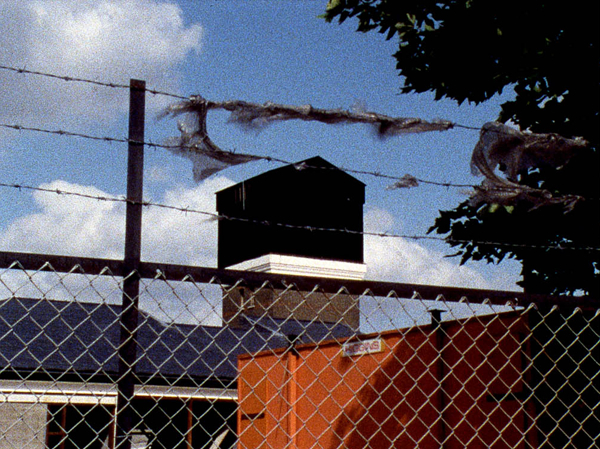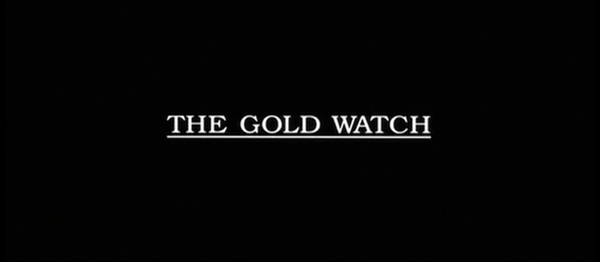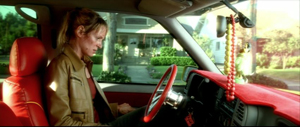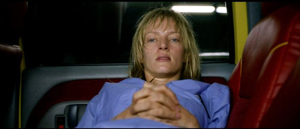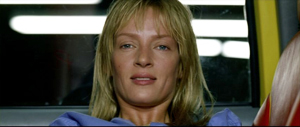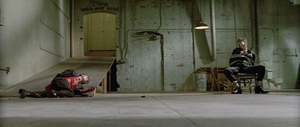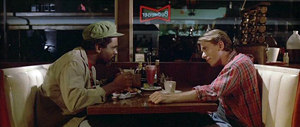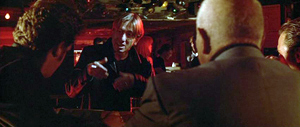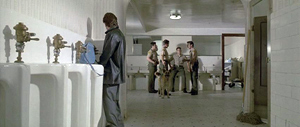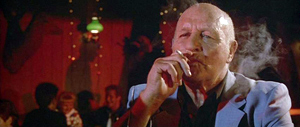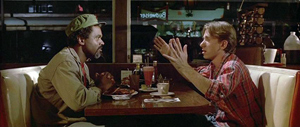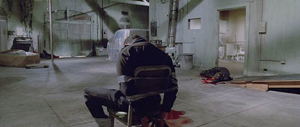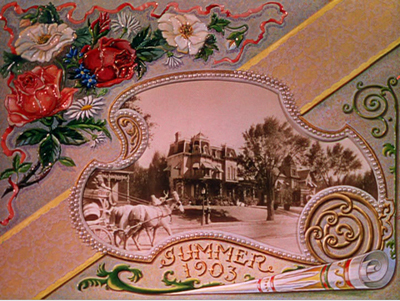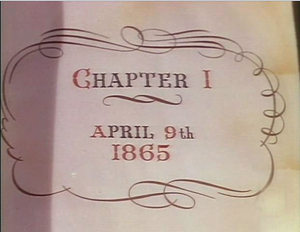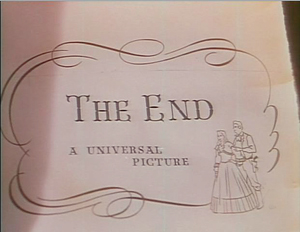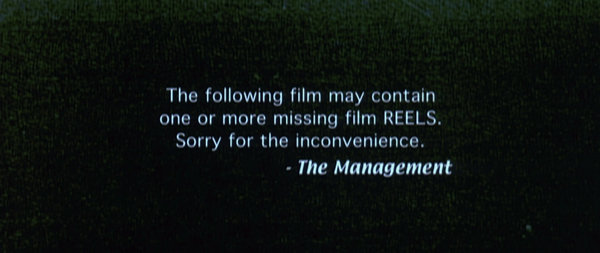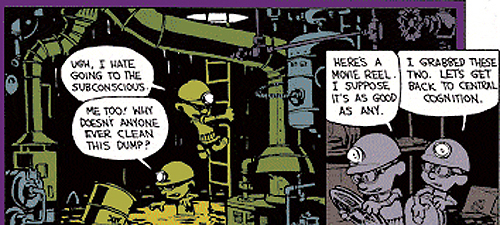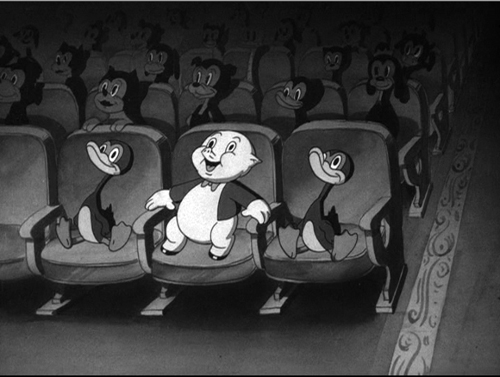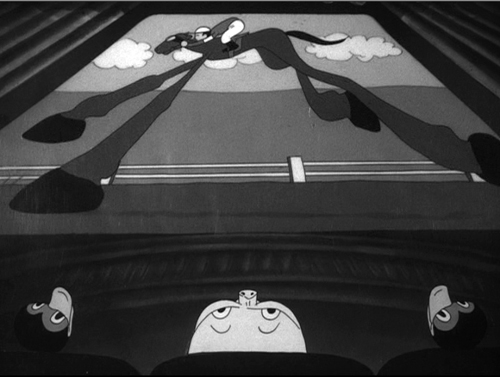Archive for the 'Society for Cognitive Studies of the Moving Image' Category
An evening with Mr. Smith
Dad’s Stick (John Smith, 2012).
DB here, from London:
Last week we held another annual meeting of the Society for Cognitive Studies of the Moving Image. I think it’s safe to say that a hell of a time was had by all. I hope to file a report on some of what was said in nearly 100 presentations across 3 ½ days. For now I want just to note a conference highlight that deserves special notice.
 English filmmaker John Smith has been working since the mid-1970s, originally in 16mm and now in HD video. On Thursday 18 June, several lucky participants got a very substantial sampling of his career’s achievement in an evening retrospective.
English filmmaker John Smith has been working since the mid-1970s, originally in 16mm and now in HD video. On Thursday 18 June, several lucky participants got a very substantial sampling of his career’s achievement in an evening retrospective.
In their visual wit and their emphasis on perceptual shifts, Smith’s films owe something to the international Structural Film trend, but they stand out by their wit and their almost classical beauty. I saw affinities with Hollis Frampton, especially in Associations (1975), in which a test of word-associations slips hilariously out of control. But Smith seems to lack Frampton’s interest in poeticizing scientific and philosophical concepts. The work sampled in our session was characterized by sensuous appeals: precise framing, saturated color, image-sound counterpoint, and richly detailed landscapes. The conceptual element entered as teasing jokes or half-formed narratives.
I had seen three or four before. Hackney Marshes–November 4, 1977 wasn’t in the program, but Kristin and I referred to it in Film History: An Introduction, because of its brash editing patterns. More famous, I suppose, and screened on Thursday, was The Black Tower (1985-87, below), with its oppressive rectangle looming over a striking variety of locales. The film keeps cutting among widely different vistas and neighborhoods, each with the tower visible in middle distance. The associations pile up: state surveillance, a prehistoric monolith, a dark temple, or an alien spacecraft. It was a pleasure to see again.
Altogether different is another of Smith’s most famous works, The Girl Chewing Gum (1976). A busy street is rendered strange by the soundtrack, in which a commentary seems to be directing the whole ensemble of passersby and traffic. Quite soon the voice-over turns into something quite odd. I find a whiff of Monty Python in this charming lesson in image/sound interference. (You can watch it on Vimeo here.)
One of the most striking selections was Blight (1994-96). The demolition of a nearby building becomes, through Smith’s maniacally locked-down camera, a study in abstract composition and eerie movement. My stills can’t suggest the way in which apparently fixed timbers and bricks suddenly shift or fall, moved by no visible hand. The music by Jocelyn Pook further “defamiliarizes” imagery of collapsing walls and exposed wiring. And the tattered man above seems to be watching the whole proceedings.
The program concluded with recent work. Flag Mountain (2010, above) elicited much comment. Fixed stop-motion telephoto shots of a mountain in Nicosia become almost hallucinatory in vibrant HD video and rapid day/night alternations. Dad’s Stick (2012, above) is a lovely tribute to Smith’s father, but it’s also a witty game of form. What seems at first to be a voluptuous abstract painting turns out to be something more mundane, but now mysterious in its accidental beauty. As a bonus, you get a good-natured teasing of art critics’ jargon. Part of Dad’s Stick is here.)
John proved a delightful and modest commenter on his work. He points out that the fixity of each image allows him to treat them as discrete items, like letters of an alphabet, so that the cutting has a crisp force. He’s come to like HD video, but yearns to “get out the old Bolex and shoot one last film.” He declines all the standard labels—avant-gardist, experimental filmmaker, maker of “artist’s films.” He thinks that his films can be appreciated by anybody who’s open-minded, and I think we all agreed. Quiet yet powerful, John Smith’s work seems to me to attest to the continuing relevance of artisanal filmmaking.
You can visit John’s website here. A large selection of his work is available on the three-DVD set John Smith, available from Lux here. The discs aren’t region-coded. Every university should have this set, as well as the Cinema 16 collection, British Short Films, which includes work by John and his contemporaries.
Thanks to Tim Smith, Murray Smith, and John Smith (no relation, none at all) for arranging this wonderful evening.
The Black Tower (John Smith, 1985-1987).
The 1940s are over, and Tarantino’s still playing with blocks
Pulp Fiction (1994).
Trigger warning: This blog is about Quentin Tarantino, Walt Disney, and Henry James. Those who find violent analogies disturbing should avoid what follows.
DB here:
Every narrative film is made out of parts. Normally they just whisk by us, but sometimes our attention is called to them as parts. Occasionally, we sense that the whole movie is made out of large-scale chunks.
Take Pulp Fiction (1994). It consists of scenes grouped into larger blocks, some marked by fade-ins and outs and others with titles, like chapters in a book. The diner opening is set off as a unit before the credits. The ensuing visit of Jules and Vincent to the apartment of the welshing punks is ended in a fade-out. We then get a section tagged “Vincent Vega and Marsellus Wallace’s Wife.” After that portion fades out, there follows a sequence introducing the young Butch as a boy, presented with his father’s gold watch. Then Butch, now grown up, heads out to the boxing match. Another fade, and we get a title, “The Gold Watch.”
That could be seen as simply a belated chapter head for the entire Butch section, boyhood and prizefighting career. Or it could mark the start of another, much longer block: the aftermath of the fight and Butch’s flight from Marcellus Wallace. Either way, the sense of a film composed of large-scale parts is very strong. As the film goes along, we realize that each block tends to concentrate on certain characters and provide distinct, sometimes overlapping, stretches of time.
For many viewers, I suspect, Pulp Fiction was their introduction to strategies of block construction in movies. Those of us studying film history had seen it in various guises before, but seldom so cleverly and explicitly worked out as in Tarantino’s film. And I’m not sure even film historians realized how much Tarantino owed to earlier traditions.
In The Way Hollywood Tells It, I suggested that some of the experimental trends in 1990s-2000s cinema were indebted to Hollywood in the 1940s. This is especially evident in the neo-noir films of those years, like The Underneath (1995), The Usual Suspects (1995), and Memento (2001). Now that I’m writing a book on that earlier period, I realize that studying the 1990s films, has led me to think about something that I hadn’t noticed—how interested 1940s filmmakers were in building movies out of blocks.
Turns out that the 1940s was a kind of golden age of block construction. And Tarantino serves especially well to illustrate how that strategy can be put to use in modern times. In fact, his work is a fairly comprehensive layout of the creative possibilities of the format.
Building blocks
Some basic options for block construction were laid out fairly early in the silent era. The most famous instance was Griffith’s Intolerance (1916), which sampled four historical periods, each harboring its own distinct story. He then crosscut the four epochs, building to four “simultaneous” climaxes at the end of the film. Griffith managed to secure an unprecedented level of suspense by alternating portions of his blocks.
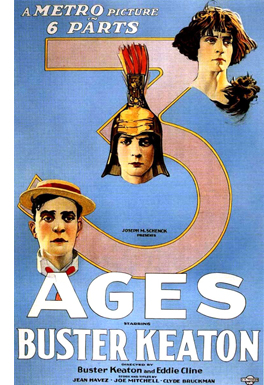 Griffith also wanted to prove a conceptual point, that intolerance reappeared at different times in different guises. He understood one of the major attractions of block construction: It asks us to compare and contrast.
Griffith also wanted to prove a conceptual point, that intolerance reappeared at different times in different guises. He understood one of the major attractions of block construction: It asks us to compare and contrast.
Directors who wanted to achieve the same comparison among different historical periods took the more obvious option and laid each separate story out, one after the other. We see the result in Dreyer’s Leaves from Satan’s Book (1920), Lang’s Der müde Tod (Destiny, 1921), and The Three Ages (1923), Buster Keaton’s parody of Intolerance. So this construction by integral blocks of time, laid end to end, was useful for comparing several self-contained stories.
Can you get the same sort of effect when sections of the same story are separated out in blocks? Yes, you can. The classic example would be parallel flashbacks. In Citizen Kane, an ongoing present, the reporter Thompson’s investigation, brackets long flashbacks that serve as parallel architectural parts—trips to the past, showing Kane as seen by others. We’re coaxed to compare Kane’s actions at different points in his life, as well as the various sides of him seen by his associates.
Here, as sometimes happens, the blocks are marked off not only by time period but by varying viewpoints. The alternation between the present and long stretches of the past, focused around one character and then another, characterizes many 1940s flashback films, such as The Killers (1947) and A Letter to Three Wives (1949).
Tarantino made alternating block construction the basic principle behind Reservoir Dogs (1992), which shuttles between the aftermath of a botched robbery and the planning that led up to it. One model he has acknowledged is Kubrick’s The Killing (1955), which itself transposed into cinema the overlapping point-of-view blocks that were present in Lionel White’s source novel Clean Break.
Elsewhere on the blog I’ve talked about how flashbacks can be nested inside one another, like Russian dolls. Examples from the 1940s include Passage to Marseille (1944) and The Locket (1946), and these lengthy sections surely count as blocks. Here the blocks serve less to compare dramatic situations than to fill in backstory. The blocks are lumps of exposition. In addition, blocks also can usefully delay events, creating suspense and padding the plot to its proper length. (Form often follows format.)
Tarantino embedded flashbacks within flashbacks in Kill Bill Vol. 1 (2003) for just these purposes. Let’s assume that the early sequence (Chapter One) showing the Bride attacking and killing Vernita, her second victim, is a benchmark for the narrative present. That ends with her reading her list of targets. Chapter Two, which follows, initiates a flashback going back several years. In the course of that, the Bride escapes from the hospital and sets out to kill O-Ren, who’s her first victim. And in the course of that long flashback, framed by the Bride lying in the Pussy Mobile, we get a nested one, dubbed “Chapter Three: The Origin of O-Ren.” That eight-minute anime fills in the life story of the queen of the Tokyo underworld before we return to the Bride’s quest for her.
The anime sequence is closed off by a return to the Bride recovering in the Pussy Mobile.
The flashback-within-a-flashback supplies exposition, creates a parallel to what we’ve seen at the film’s start (Vernita’s little daughter discovering the Bride’s murder of her mother), and sharpens our curiosity about the Bride’s trip to Japan. We stay in that Japan-related flashback for the rest of Vol. 1. The plot won’t take us back to the present, after the Bride’s killing of Vernita, until the black-and-white beginning of Vol. 2.
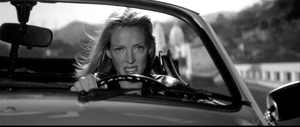
A trickier Chinese-boxes structure appears in Reservoir Dogs. The present-time situation is the gathering of the surviving hoods in the warehouse. There are flashbacks to the planning stages of the holdup, each attached to one man’s viewpoint and tagged with his alias.
In the flashback attributed to Mr. Orange, the police mole, we start with him identifying himself to the tortured cop in the warehouse. We move to the past, when Mr. Orange meets a contact in a diner and explains that the gang took him in. That leads to a nested flashback showing him at his audition.
To gain the gang’s trust, Mr. Orange tells a heavily rehearsed fake anecdote about evading the cops during a drug swap. And even that gets an embedding: the false anecdote is presented visually, as a scene in a men’s toilet.
Then we come out of the nested flashbacks in proper order: back to the meeting with the gang, then to the diner, and several scenes later, back to the present situation in the warehouse.
A lying flashback is embedded in a flashback that’s itself embedded within a flashback. The whole shebang becomes a complex block labeled “Mr. Orange.”
Most flashback films use the trips to the past to revisit characters known to us in the present. But some films use the flashback option to tell independent stories. Forever and a Day (1943) is a biography of a house, supplying a history of the house from its origins to its sufferings during the Nazi bombing of London. An even clearer example is Tales of Manhattan (1943). It traces how a coat of tails is passed down the social pecking order, from an elegant actor to a sharecropping community. No characters tie the episodes together, only the coat and some thematic motifs. Again, the blocks encourage us to contrast how different social classes use the tailcoat.
I don’t find Tarantino picking up this circulating-object idea, but it has been reused in Twenty Bucks (1993), American Gun (2006), and other films. Somewhat in the same spirit, though, is Tarantino’s Death Proof, the second feature in Grindhouse (2007). The first half of the original theatrical release concerns four young women who are targeted by Stuntman Mike, a free-range master of vehicular homicide. All the women are killed, but in the second half Mike meets his match in a quartet of car-crazy film staffers, one of whom is a stuntwoman while another is an expert driver. Mike is like the coat of tails in Tales of Manhattan: the only link between the film’s episodes.
Flashbacks can, of course, be much briefer, and when they are they don’t usually have the heft of blocks. But when a scene is replayed as a flashback, both the replay and the original scene can stand out. The flashback replay of the murder of Monty in Mildred Pierce (1945) gains a certain solidity, since it reveals things that were suppressed (and fudged) in the first go-round. (Go here for the entry and the analytical video discussing these scenes.) Another example is the conflicting testimony that includes a lying flashback in Crossfire (1947).
Pushing beyond his predecessors, Tarantino tries a more elaborate replay in Jackie Brown (1997). He presents the shopping-mall money exchange three times, from different characters’ attached viewpoints. The side-by-side replays make the whole money drop stand out as a block, as does the chapter title (“Money Exchange: For Real This Time”) and the length (over twenty minutes). A practice session for the exchange forms a parallel block, with its own introductory title (“Money Exchange: Trial Run”).
Episodic memories
Meet Me in St. Louis (1944).
If flashbacks, played once or many times, provide the most common sorts of blocks, big or small, there are other possibilities. You can, for instance, build your plot out of chronological but independent blocks within the same locale and time frame. Three Strangers (1946) is a straightforward example.
A woman invites two men into her apartment and suggests they share the price of a sweepstakes ticket. They will then reunite on the day the ticket falls due to see if they’ve won. After the men agree, the plot follows all three separately, with long blocks devoted to each. Their stories don’t intersect. There is a little bit of crosscutting among them, but the characters don’t reunite until the climax.
The advantage of this diverging-reconverging construction is that you can tell several stories, each with its own dramatic arc, within a larger frame that brings them all to a decisive conclusion. If you pull it off, it can deepen characterization (we spend more time with the protagonists) and perhaps mark you as a virtuoso. A flashy example is Mystery Train (1989), which provides the moment of the story lines’ convergence as a sound rather than a face-to-face encounter.
The risk of this format is that some separate stories may seem less interesting than the others. An ordinary film moves along quickly enough that we can wait out tiresome characters or situations, but in this construction we’re stuck for a while. This cost-benefit analysis may be one reason that most Hollywood plots try to integrate their story lines fairly tightly. That way you can keep the audience aware that each scene has consequences for everything that follows.
Tarantino uses the parallel block device in Inglourious Basterds (2009). Here two main story strands—Shosanna’s efforts to elude Colonel Landa and the mission of Aldo Raine’s combat team—develop independently in lengthy scenes. There’s some alternation, but the plot lines don’t converge until the movie theatre conflagration. Interestingly, both Three Strangers and Inglourious Basterds fill out their dimensions by including minor subplots (the adventure of Archie Hicox developing its own interest in Basterds).
The simplest version of block construction lets one distinct story episode follow another. The most common case is the Hollywood musical, which contains numbers, either as stage performances or as sung-and-danced scenes. Each number tends to have an internal coherence and sharp boundaries that make it a detachable unit. (So detachable that it can stand on its own in documentaries like That’s Entertainment! of 1974 and its sequels.)
One musical that includes larger-scale segments—quite big blocks,, actually–is Meet Me in St. Louis (1944). The plot consumes about a year in the life of a family, and it opens with a candy-box title card specifying “Summer 1903.” It’s followed by two more seasonal chapters, identifying autumn and winter of the year, before we get “Spring”—a title with no date, suggesting a kind of eternal renewal that will solve the characters’ problems. Within each of these blocks, events typical of each season, including Halloween and Christmas, reinforce the sense of these as varied sections.
This sort of explicit chaptering in the 1930s-1940s is usually reserved for films framed by opening pages of a book, as in Salome, Where She Danced (1945).
Often, as in Salome, the book frame is dropped from the rest of the movie, although it might reappear to provide closure.
New forms of self-conscious chaptering became prominent in later years, as with the quotations announcing sections in Hannah and Her Sisters (1985). Most of Tarantino’s films use chapter titles to some extent, with the Kill Bill movies providing the most elaborate examples. Those films are presented as two “volumes” containing ten distinct “chapters.” Some are bulked out by flashbacks, some aren’t, but all these chapters become prominent through sheer length. Chapter Nine, which settles the fates of both Budd and Elle Driver, runs almost half an hour, and the final chapter lasts over forty minutes.
Moreover, the chapters, as in Pulp Fiction, aren’t arranged in 1-2-3 order, so we’re invited not only to compare parts but figure out their chronology. The very first chapter teases us with this problem.
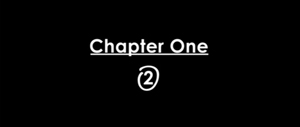
The circled 2 is explained when we understand that Vernita is the second target on the Bride’s list.
Still other forms of big-chunk construction came into prominence in the 1940s. Think for instance of what were called “episodic” films, movies that inserted separate stories, often thematically connected, into a general framing structure. For example, the team that gave us Tales of Manhattan also produced Flesh and Fantasy (1943). The situation is of two men discussing superstition in a library. One takes down a book of stories and we see, enacted, three tales of the fantastic. At the end we return to the library.
This cinematic anthology was sometimes called an omnibus film, and it proved very popular around the world; examples are Dead of Night (UK, 1945) and the many Italian and French collections (e.g., The Seven Deadly Sins, 1952; Spirits of the Dead, 1968). It persisted for decades in the US (New York Stories, 1989; Night on Earth, 1992) and internationally (Paris, je t’aime, 2006). Tarantino’s contribution to the genre was Four Rooms (1995). The framing situation is that of a hotel, and three other directors contributed episodes showing what happens to various guests.
Walt Disney exploited block construction in all these ways during the 1940s. He filled out a live-action film with embedded stories (Song of the South, 1946) and interspersed cartoons with travelogue footage (Saludos Amigos, 1942). The all-animated Three Caballeros (1944; above) assembled several South American tales by means of a frame story showing Donald Duck getting gifts from below the border and dancing with his amigos. (This is a brilliant movie, as I suggest in this ancient but ageless post.)
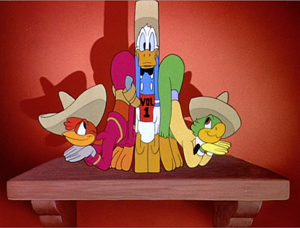
By contrast, Make Mine Music (1946) and Melody Time (1948) give their animated musical numbers only minimal framing.
Most famous of the Disney anthologies, of course, is Fantasia (1941). Here a program of classical pieces is illustrated in cartoon sequences. The frame is provided by Leopold Stokowski at the podium and Deems Taylor, a famous music popularizer, supplying radio-style commentary in the breaks. Strange though it sounds, Tarantino (along with Robert Rodriguez) does something similar when he gives us two exploitation features, Planet Terror and Death Proof, surrounded by trailers and ads. Just as Disney posits a mock trip to the concert hall, Tarantino reimagines a night at a drive-in or an inner-city movie house.
What about Django Unchained (2012)? I think Tarantino has done something clever here. At what seems to be the climax, Dr. Schultz is killed and Django, after a fierce gunfight, is recaptured and sold to slave traders. The drama seems to be finished. But then the movie starts over, and a twenty-five-minute stretch of new action shows Django escaping the traders and returning to Candyland to wreak his revenge. Tarantino has tacked on a second, lengthy ending; block structure yields a calculated anticlimax.
Modern, middlebrow, mysterious
I guess what I’m always trying to do is use the structures that I see in novels and apply them to cinema.
Quentin Tarantino, 1993
Where did the 1940s impulse toward block construction come from? In classical Hollywood cinema, I see two primary literary sources: modernism and its offshoots in “mild modernism” (what Dwight Macdonald called “midcult”); and mystery fiction.
Fictional tales had long been broken into segments, and chapter divisions are of course very old. Assembling tales out of blocks likewise has antecedents as far back as ancient Egypt, Homer, and the Bible. Epistolary and found-manuscript fiction gravitated naturally to block arrangement. Dickens gave Little Dorrit (1855-1857) a balanced two-part layout, and he built Bleak House (1852-1853) on alternating segments in two narrative voices.
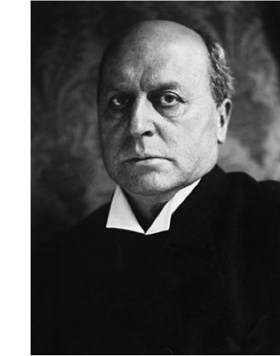 By the end of the nineteenth century, writers reflected on such problems of carpentry. Here is Henry James on carefully dividing The Wings of the Dove into discrete sections. (The italics are his.)
By the end of the nineteenth century, writers reflected on such problems of carpentry. Here is Henry James on carefully dividing The Wings of the Dove into discrete sections. (The italics are his.)
There was the ‘fun’ . . . [of treating the actions as] sufficiently solid blocks of wrought material, squared to the sharp edge, as to have weight and mass and carrying power; to make for construction, that is, to conduce to effect and to provide for beauty.
Likewise, The Awkward Age (1899) was conceived as a situation to be illuminated by different characters, or “lamps,” each participating in a single social occasion. Consequently the contents as a series of chapters (or “books”) with character titles (not unlike what Tarantino did in Reservoir Dogs): “Lady Julia,” “Little Aggie,” “Mr. Longdon,” and so on.
This sort of explicit geometry was sometimes taken up by modernist writers. Faulkner breaks The Sound and the Fury (1929) into large parts determined by place, time, and character narrators. John Dos Passos intercuts chunks of different sorts of texts (news stories, “camera-eye” views) to create the trilogy USA (1930-1036). Other modernists avoided tagging sections but made sure to give each one a blocklike singularity, as Joyce famously does with the chapters of Ulysses. Each one is keyed to a section of Homer’s Odyssey, a time of day, a symbol, and so on, and treated in a different literary technique.
Middlebrow writers, who tried to make modernism more user-friendly, seized on block construction. A prime example is Thornton Wilder’s Bridge of San Luis Rey (1927), which traces three parallel stories of people who died on the bridge when it collapsed. Less famous is Rex Stout’s fascinating How Like a God (1929), which alternates two sorts of blocks: one in italics, past tense, third-person narration, and labeled with letters of the alphabet; a second in roman type, present tense, second person (“You…”), and given a numerical order. The labels and fonts help us figure out the chronology of the story (and grasp the thoughts of the main character). Kenneth Fearing’s mildly modernist novel The Hospital (1938) borrowed from Dos Passos in shifting viewpoints among many characters, even objects, and his Clark Gifford’s Body (1942) anticipates Pulp Fiction in drastically shuffling discrete blocks out of story order.
At a more popular level, mystery fiction developed its own strategies for block construction. As a genre, mystery and detective stories are dedicated to formal play with narrative options. (Hence their interest for us narratologists.) Mysteries are frankly artificial, even gamelike, and so seek out ways to trick us.
The love of artifice often yields embedded stories, as in A Study in Scarlet (1887), and plays with point of view (famously, Christie’s Murder of Roger Ackroyd, 1926). While Dickens and James were testing block construction in the “serious” novel, Wilkie Collins was developing the “casebook” format: a collection of documents—letters, testimony, discovered manuscripts—that served as a series of blocks. Dracula (1897) also helped popularize the format. It was revived in Dorothy L. Sayers and Robert Eustace’s The Documents in the Case (1930) and Perceval Wilde’s Design for Murder (1941). And just as Stout had made typography and chapter headings formal devices, so did mystery writers use them to build suspense and their readers (e.g., Anita Boutell, Death Has a Past, 1939).
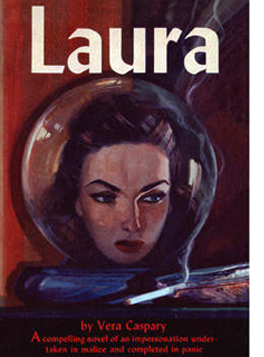 We tend to take such trickery as typical of the sleuth-and-puzzle detective tradition, but not of the hard-boiled detective tales and suspense thrillers we associate with the 1930s and 1940s. Yet writers in those traditions sometimes shift a story forward and backward in big blocks, as with Don Tracy’s Criss Cross (1934, source of the 1949 film). Vera Caspary’s Laura (1943) exploited the casebook format, which was partly transposed into the film version. Kenneth Fearing, trying his hand at mystery fiction, shifted first-person narration among several characters (including a dead one) in Dagger of the Mind (1941) and The Big Clock (1946). Bill S. Ballinger’s Portrait in Smoke (1950) paralleled a first-person account of an investigation with third-person chapters that trace what happened in the past.
We tend to take such trickery as typical of the sleuth-and-puzzle detective tradition, but not of the hard-boiled detective tales and suspense thrillers we associate with the 1930s and 1940s. Yet writers in those traditions sometimes shift a story forward and backward in big blocks, as with Don Tracy’s Criss Cross (1934, source of the 1949 film). Vera Caspary’s Laura (1943) exploited the casebook format, which was partly transposed into the film version. Kenneth Fearing, trying his hand at mystery fiction, shifted first-person narration among several characters (including a dead one) in Dagger of the Mind (1941) and The Big Clock (1946). Bill S. Ballinger’s Portrait in Smoke (1950) paralleled a first-person account of an investigation with third-person chapters that trace what happened in the past.
Trends in high, middlebrow, and “low” literature like crime stories had a large impact on 1940s cinema. Just as important, this formal play with narrative conventions, including block construction, continued for decades, right up to the present. Most pertinent to Tarantino is the trend toward rigorous construction we find in crime fiction from the 1960s onward.
My own favorite example is Richard Stark (aka Donald Westlake), who conceives nearly all his novels in a rigid four-part format. Tarantino seems to prefer Elmore Leonard and Charles Willeford. He isn’t given as much credit for his bibliophilia as his cinephilia, but it’s evident that he has thought a fair amount about how to bring literary techniques into cinema.
Novels go back and forth all the time. You read a story about a guy who’s doing something or in some situation and, all of a sudden, chapter five comes and it takes Henry, one of the guys, and it shows you seven years ago, where he was seven years ago and how he came to be and then like, boom, the next chapter, boom, you’re back in the flow of the action.
For example, in Rum Punch, the source novel for Jackie Brown, Leonard’s chapter-breaks usually shift our attachment from one character to another, and the new chapter may insert backstory at the start. Leaving Jackie Brown’s deal with the Feds hanging, Chapter 14 starts with Melanie sunbathing and thinking about her past. A chunk of exposition, like a film flashback, explains how she became “the tan blond California girl.” Tarantino was unusually sensitive to fiction writers’ switches in time and viewpoint, and he clearly admired the opportunities opened up by solid chapter-length blocks.
I’m not suggesting that Tarantino spends his weekends perusing Henry James or Thornton Wilder. It’s just that techniques similar to theirs have pervaded popular literature. Indeed, they were already at play in one popular genre that has always used literary artifice to shape our experience. To this day, as in King’s 11/22/63, mysteries and thrillers use block construction to promote suspense, play with alternative possibilities, make us reevaluate story situations, and engage us in a game of self-conscious form.
Sometimes current developments put the past in a new perspective. The emergence of “minimal music” (Glass, Reich, La Monte Young) suddenly showed Satie’s ideas about repetition to be more fertile than most of us had thought. Similarly, Tarantino’s work forced me to think about contemporary storytelling strategies, but it also asked me to consider more distant sources of those trends.
Studying film history is valuable for its own sake; it’s just damn interesting. Needing further justification, sometimes historians go on to say, especially to students: We study history to better understand the present. That’s surely true, but so is this: We study the present to better understand history.
Henry James’ discussion of block construction is in “Preface to The Wings of the Dove” in The Art of the Novel: Critical Prefaces (New York: Scribners, 1934), 296. Tarantino’s comments about novels and films come from Graham Fuller, “Answers First, Questions Later,” in Quentin Tarantino Interviews, ed. Gerald Peary (University Press of Mississippi, 1998), 53; Jeff Dawson, Quentin Tarantino: The Cinema of Cool (Applause, 1995), 69.
A useful discussion of how chapter divisions relate to plot is Philip Stevick, “The Theory of Fictional Chapters,” in The Theory of the Novel, ed. Stevick (The Free Press, 1967), 171-184. You can sample it here.
Neo-noir encouraged many filmmakers to explore block construction. Three quick examples: Soderbergh in Out of Sight (1998; from a Leonard book), Christopher Nolan in Following (1998), and Shane Black in Kiss Kiss Bang Bang (2005, which split up into chapters corresponding to one popular screenplay formula). Nolan proved keenly interested in this compositional approach; see our ebook, Christopher Nolan: A Labyrinth of Linkages. More recently, Wes Anderson’s films deploy some tricky versions of block construction.
Block construction is also apparent in comic books, and Tarantino is clearly an aficionado of those traditions too. That influence should be taken into account for a fuller analysis of his narrative techniques. Also, too: The influence of Godard, especially in the “tardy” title insertions coming after the segment has started (e.g., one way to take “The Gold Watch”).
The expanded, stand-alone feature version of Death Proof displays block construction in filling out the “missing reel” portion of the first story and creating a new block, a ten-minute scene of the second “girl posse” at a convenience store. The scene starts with Stuntman Mike before shifting to the young women. It makes Mike even more a connecting link between the film’s two episodes, while Mike’s stalking and spying fulfills Tarantino’s claim that Death Proof is a slasher movie.
Embedded stories or flashbacks exemplify what researchers call “ring construction.” Bill Benzon has explored this in many critical analyses, as here with the 1954 Godzilla/Gojira.
For more on Inglourious Basterds, see our entry here and as revised in Minding Movies. We analyze the money-drop sequence in Jackie Brown in Chapter 7 of Film Art: An Introduction. Kristin discusses the titles and segmentation of Hannah and Her Sisters in Chapter 11 of Storytelling in the New Hollywood.
Thanks to participants in the 2014 conference of the Society for Cognitive Studies of the Moving Image for their comments on some of the ideas presented here. Thanks also to Matthew Bernstein, biographer of Walter Wanger, for in-depth discussion of Salome, Where She Danced.
Grindhouse (2007).
COGNITIVISTS STORM BIG APPLE! BIG APPLE ASKS, “WHAT’S A COGNITIVIST?”
The final SCSMI 2012 banquet, held on the tenth floor of the NYU Kimmel Center for University Life, Rosenthal Pavilion.
DB here:
Most years I offer an entry recording some events at the annual meeting of the Society for Cognitive Studies of the Moving Image. We did hold our conference–and a swell one it was, starting Wednesday at Sarah Lawrence College and wrapping up at the Cinema Studies department of New York University last Saturday. I heard many excellent papers and panel discussions. (The schedule is on a pdf here.) The event was also graced by keynote lectures by Alva Noë and Noël Carroll, and a night of splendid, eye-warping films by Ken Jacobs, no stranger to this blog (here and here and here). Malcolm Turvey of Sarah Lawrence and Richard Allen of NYU did an excellent job of coordinating the SCSMI event.
But I can’t offer my usual conference roundup this time. Kristin and I just got back last night, and we have only three days in Madison before taking off for Il Cinema Ritrovato. In those three days we have a hell of a lot to do, including setting me up for Medicare (!), as I’ll turn 65 during our trip. But I did want to supplement a small runup piece to the conference a couple of weeks back.
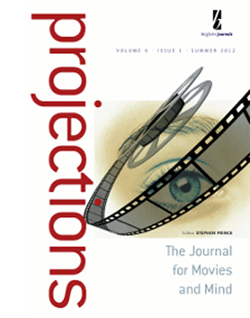 A few days after that post, I received the most recent issue of Projections, a journal with which SCSMI is affiliated. It’s stuffed with worthwhile pieces: Gerald Sim’s overview of the digital revolution (if any) in cinematography; Barbara Flueckiger’s essay, “Aesthetics of Stereoscopic Cinema”; Mark J. P. Wolf’s study of imaginary worlds on film; and James E. Cutting, Kailin L. Brunick, and Jordan DeLong’s correction of one claim they made about shot lengths and film acts. (Kristin discusses their project in this entry from last year.)
A few days after that post, I received the most recent issue of Projections, a journal with which SCSMI is affiliated. It’s stuffed with worthwhile pieces: Gerald Sim’s overview of the digital revolution (if any) in cinematography; Barbara Flueckiger’s essay, “Aesthetics of Stereoscopic Cinema”; Mark J. P. Wolf’s study of imaginary worlds on film; and James E. Cutting, Kailin L. Brunick, and Jordan DeLong’s correction of one claim they made about shot lengths and film acts. (Kristin discusses their project in this entry from last year.)
As if all this weren’t enough, the issue includes a lively and probing roundtable on Continuity Editing, with a superb synoptic article by Tim Smith summing up his eye-tracking research. (His study of There Will Be Blood is our now-classic guest blog.) Tim’s article is an ideal introduction to his wide-ranging research program. Several other scholars comment on Tim’s “attentional theory of continuity editing”: Paul Messaris, Cynthia Freeland, Sheena Rogers, Malcolm Turvey, Greg Smith, and Daniel T. Levin and Alicia M. Hymel. Tim replies to their criticisms in a follow-up piece. This sort of dialogue occurs very rarely in film studies, and it’s to be applauded. I think such serious and courteous exchanges are the mark of a mature, or at least maturing, discipline.
You can learn more about Projections here and read a sample issue here. If your library doesn’t subscribe, maybe you can hint that it should. Although it’s hard to determine the image format of the swirling filmstrip on the cover (image ratio and perfs are puzzling), note that at least it is film.
I learned so much from this year’s get-together that you shouldn’t be surprised if pieces of it float into upcoming blog entries. And in 2013, there’s always Berlin.
From Sam Wass, Parag Mital, and Tim Smith’s paper, “Cutting through the blooming, buzzing confusion: Signal-to-noise ratios and comprehensibility in infant-directed screen media.”
In cognito (we trust)
From Calvin & Hobbes, 10 April 1994.
DB here:
Every year at about this time, I trumpet the upcoming convening of the Society for Cognitive Studies of the Moving Image. This year’s powwow is held at picturesque Sarah Lawrence College, under the auspices of Professor Malcolm Turvey, no stranger to this blog. The final day of it will take place at NYU’s Cinema Studies Department. I had to miss last year’s conference for health reasons, but I’ll be there this year with a paper on 1940s Hollywood narrative.
Some earlier blog entries sketch out my take on what’s interesting about the group’s work. You can find treatment of the 2008 Madison gathering here and here; the 2009 Copenhagen event here and here with an epilogue about Lars von Trier and Asta Nielsen; and afterthoughts on the 2010 Roanoke meeting here. Last year, because I couldn’t go, I offered a web essay, here. This discusses my current thinking about the cognitive research framework.
This year, although I’m going, I’m again offering a new web essay. It’s about how models of mind (Gestalt, psychoanalytic, cognitive, etc.) have shown up in film theory and criticism. The piece is organized chronologically, and it tries to tie ideas about the psychology of cinema to a history of filmmaking: the theories I discuss emerge as responses to changes in form, style, and theme. The essay will eventually be reprinted in Art Shimamura’s anthology, Psychocinematics: Exploring Cognition at the Movies, forthcoming from Oxford University Press. Art’s collection gathers many cutting-edge essays from SCSMI members.
A sideways note: I learned recently that my old book, Narration in the Fiction Film (1985), sold 470-some copies last year. That’s a lot for an old academic study, especially one with many used copies in circulation. I infer from this (good cognitivists make inferences) that some instructors are using it in courses. I’m grateful, naturally, but I want to signal that I’ve altered some of the views I expressed in that book. If a professor is using my book to exemplify the cognitive perspective on narrative, I’d urge him or her to consider as well the web essay I already mentioned, “Common Sense + Film Theory = Common-Sense Film Theory?” In addition, my most recent answers to questions about filmic storytelling, in which narration is treated as one aspect of a larger process, can be found in “Three Dimensions of Film Narrative,” in the collection Poetics of Cinema. In other words: I hope I’ve learned something since 1985.
The week following the SCSMI gathering, UCLA is hosting Visual Narrative: An Interdisciplinary Workshop on 20-22 June. This very promising event hosts presentations and commentaries from linguists, philosophers, and a couple of SCSMI star psychologists. Dan Levin has already made appearances in this blog (notably here), and Tim Smith, Continuity Boy, has contributed our perennially popular guest entry, “Watching You Watch THERE WILL BE BLOOD.” The distinguished philosopher of art George Wilson, author of Narration in Light, will also be there. Thanks to Rory Kelly, one of the Workshop’s organizers, for tipping me off.
After SCSMI (from which, or about which, I hope to blog), we’re off to Bologna, so expect more of our usual reportage from Cinema Ritrovato, that frenzy of movies and movie lovers. Coming up next, though, there’s Bette Davis to reckon with.
Cognition is important, but so is perception, as every front-row sitter knows. From The Film Fan (1939, Warner Bros., Bob Clampett).













